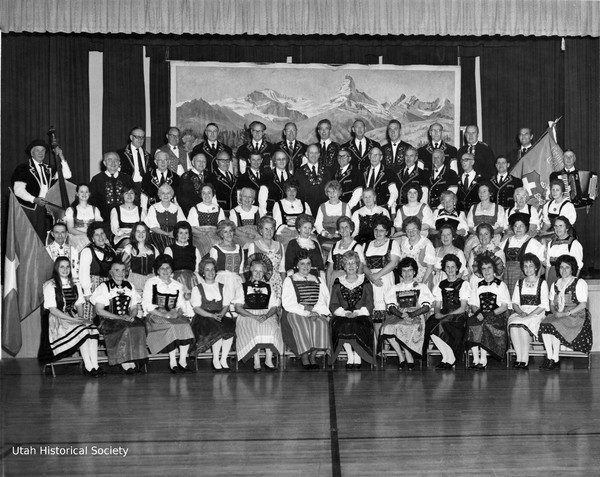Dublin Core
Title
Midway’s Swiss Party for their Rural Community
Description
On the east side of the Wasatch Mountains, you can find a little slice of Switzerland right here in Utah. Learn more about Midway’s Swiss Days celebration.
Midway City, located in the Heber Valley on the east side of the Wasatch Mountains, boasts beautiful alpine views and a strong sense of community. A yearly festival called Swiss Days uses Swiss culture – from cows to chocolate to yodeling – to boost town pride and draw in visitors. But at the heart of Swiss Days, one finds not a celebration of another country but rather, a celebration of Midway itself.
Initially called "Harvest Days" Midway's fall festival began as an opportunity for farmers to highlight their crops each September. Then in the 1940s, the town decided to rebrand "Harvest Days" to "Swiss Days" to attract visitors to their town’s hot springs and resorts. But, why celebrate Swiss culture? Many of the original Heber Valley settlers in the nineteenth century were Swiss families, so the festival started as an ode to that heritage.
In 1976, the nearby Pleasant Grove Review newspaper conjured up the kind of Swiss romanticism visitors might find in Heber Valley during the fall festival, including “yodelers, pretty blondes, St. Bernards, skiers, and a mysterious looking foreign espionage agent in a trench coat methodically walking through railway passenger cars.” Obscure references to spy movies aside, travelers from all over the country could get an authentic Swiss Alps fix right here in Utah – although the raclette and chocolate would be against the backdrop of the Wasatch Mountains instead. Local food, crafts, music, golf tournaments, and even an annual “Swiss Miss” beauty pageant were part of the entertainment that drew in crowds since the 1940s – and much of the festival remains the same today.
What was originally an homage to those historic Swiss settlers now attracts more than 60,000 visitors to the town every year – and the Swiss festival has become much more. Since the 1940s, Midway Swiss Days has become a staple of the rural town’s celebration of its own community. As Midway’s population changes and diversifies over the coming years, it is veering away from its mostly-Swiss, Mormon settler roots. Despite this, Swiss Days is still a big party that one event organizer said simply “is a celebration for Midway residents. This is a party for us.”
Midway City, located in the Heber Valley on the east side of the Wasatch Mountains, boasts beautiful alpine views and a strong sense of community. A yearly festival called Swiss Days uses Swiss culture – from cows to chocolate to yodeling – to boost town pride and draw in visitors. But at the heart of Swiss Days, one finds not a celebration of another country but rather, a celebration of Midway itself.
Initially called "Harvest Days" Midway's fall festival began as an opportunity for farmers to highlight their crops each September. Then in the 1940s, the town decided to rebrand "Harvest Days" to "Swiss Days" to attract visitors to their town’s hot springs and resorts. But, why celebrate Swiss culture? Many of the original Heber Valley settlers in the nineteenth century were Swiss families, so the festival started as an ode to that heritage.
In 1976, the nearby Pleasant Grove Review newspaper conjured up the kind of Swiss romanticism visitors might find in Heber Valley during the fall festival, including “yodelers, pretty blondes, St. Bernards, skiers, and a mysterious looking foreign espionage agent in a trench coat methodically walking through railway passenger cars.” Obscure references to spy movies aside, travelers from all over the country could get an authentic Swiss Alps fix right here in Utah – although the raclette and chocolate would be against the backdrop of the Wasatch Mountains instead. Local food, crafts, music, golf tournaments, and even an annual “Swiss Miss” beauty pageant were part of the entertainment that drew in crowds since the 1940s – and much of the festival remains the same today.
What was originally an homage to those historic Swiss settlers now attracts more than 60,000 visitors to the town every year – and the Swiss festival has become much more. Since the 1940s, Midway Swiss Days has become a staple of the rural town’s celebration of its own community. As Midway’s population changes and diversifies over the coming years, it is veering away from its mostly-Swiss, Mormon settler roots. Despite this, Swiss Days is still a big party that one event organizer said simply “is a celebration for Midway residents. This is a party for us.”
Creator
By Megan Weiss for Utah Humanities © 2023
Source
Image: Swiss in Utah, c 1975. The "Swiss Days" celebration was started by the “Midway Boosters,” a committee of residents who advocated for town improvements and community events. These boosters still help Midway put on events today. Image courtesy of Utah Historical Society.
________________
See “Midway Swiss Days Set for September 3 and 4, come Out,” Pleasant Grove Review, August 26, 1976, Utah Digital Newspapers, accessed November 2023; Jerry R. Springer, “Midway,” Utah History Encyclopedia, accessed November 2023; Brock Marchant, “Meaning, legacy behind Midway City’s Swiss Days,” Park Record, September 5, 2023, accessed November 2023; “Midway Utah: A History,” Go Heber Valley, accessed November 2023; Douglas F. Tobler, “Swiss in Utah,” Utah History Encyclopedia, accessed November 2023.
________________
See “Midway Swiss Days Set for September 3 and 4, come Out,” Pleasant Grove Review, August 26, 1976, Utah Digital Newspapers, accessed November 2023; Jerry R. Springer, “Midway,” Utah History Encyclopedia, accessed November 2023; Brock Marchant, “Meaning, legacy behind Midway City’s Swiss Days,” Park Record, September 5, 2023, accessed November 2023; “Midway Utah: A History,” Go Heber Valley, accessed November 2023; Douglas F. Tobler, “Swiss in Utah,” Utah History Encyclopedia, accessed November 2023.
Publisher
The Beehive Archive is a production of Utah Humanities. Find sources and the whole collection of past episodes at www.utahhumanities.org/stories.
Date
2023-12-04

